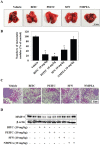Isothiocyanates suppress the invasion and metastasis of tumors by targeting FAK/MMP-9 activity
- PMID: 28969043
- PMCID: PMC5609975
- DOI: 10.18632/oncotarget.19213
Isothiocyanates suppress the invasion and metastasis of tumors by targeting FAK/MMP-9 activity
Abstract
Isothiocyanates, which are present as glucosinolate precursors in cruciferous vegetables, have strong activity against various cancers. Here, we compared the anti-metastatic effects of isothiocyanates (benzyl isothiocyanate (BITC), phenethyl isothiocyanate (PEITC), and sulforaphane (SFN)) by examining how they regulate MMP-9 expression. Isothiocyanates, particularly PEITC, suppressed 12-O-tetradecanoylphorbol-13-acetate (TPA)-induced MMP-9 activity and invasion in various cancer cell lines. By contrast, N-methyl phenethylamine, a PEITC analog without an isothiocyanate functional group, had no effect. A reporter gene assay demonstrated that BITC, PEITC, and SFN suppressed TAP-induced MMP-9 expression by inhibiting AP-1 and NF-κB in U20S osteosarcoma cells. All three compounds reduced phosphorylation of FAK, ERK1/2, and Akt. In addition, MMP-9 expression was downregulated by inhibiting FAK, ERK1/2, and Akt. Isothiocyanates-mediated inhibition of FAK phosphorylation suppressed phosphorylation of ERK1/2 and Akt in U2OS and A549 cells, along with the translocation of p65 and c-Fos, suggesting that isothiocyanates inhibit MMP-9 expression and cell invasion by blocking phosphorylation of FAK. Furthermore, isothiocyanates, abolished MMP-9 expression and tumor metastasis in vivo with the following efficacy: PEITC>BITC>SFN. Thus, isothiocyanates act as anti-metastatic compounds that suppress MMP-9 activity/expression by inhibiting NF-κB and AP-1 via suppression of the FAK/ERK and FAK/Akt signaling pathways.
Keywords: FAK; MMP-9; cancer invasion; isothiocyanates; metastasis.
Conflict of interest statement
CONFLICTS OF INTEREST The authors have declared that there are no conflicts of interest.
Figures








Similar articles
-
Isothiocyanates inhibit the invasion and migration of C6 glioma cells by blocking FAK/JNK-mediated MMP-9 expression.Oncol Rep. 2015 Dec;34(6):2901-8. doi: 10.3892/or.2015.4292. Epub 2015 Sep 18. Oncol Rep. 2015. PMID: 26397194
-
Benzyl isothiocyanate and phenethyl isothiocyanate inhibit murine melanoma B16F10 cell migration and invasion in vitro.Int J Oncol. 2017 Sep;51(3):832-840. doi: 10.3892/ijo.2017.4084. Epub 2017 Jul 27. Int J Oncol. 2017. PMID: 28766686
-
Phenethyl Isothiocyanate (PEITC) and Benzyl Isothiocyanate (BITC) Inhibit Human Melanoma A375.S2 Cell Migration and Invasion by Affecting MAPK Signaling Pathway In Vitro.Anticancer Res. 2017 Nov;37(11):6223-6234. doi: 10.21873/anticanres.12073. Anticancer Res. 2017. PMID: 29061805
-
Anti-Carcinogenic Glucosinolates in Cruciferous Vegetables and Their Antagonistic Effects on Prevention of Cancers.Molecules. 2018 Nov 15;23(11):2983. doi: 10.3390/molecules23112983. Molecules. 2018. PMID: 30445746 Free PMC article. Review.
-
Dietary isothiocyanates inhibit cancer progression by modulation of epigenome.Semin Cancer Biol. 2022 Aug;83:353-376. doi: 10.1016/j.semcancer.2020.12.021. Epub 2021 Jan 9. Semin Cancer Biol. 2022. PMID: 33434642 Review.
Cited by
-
The tetraspanin CD81 mediates the growth and metastases of human osteosarcoma.Cell Oncol (Dordr). 2019 Dec;42(6):861-871. doi: 10.1007/s13402-019-00472-w. Epub 2019 Sep 7. Cell Oncol (Dordr). 2019. PMID: 31494861
-
Synthesis and anti-glioblastoma effects of artemisinin-isothiocyanate derivatives.RSC Adv. 2018 Dec 7;8(71):40974-40983. doi: 10.1039/c8ra08162j. eCollection 2018 Dec 4. RSC Adv. 2018. PMID: 35557894 Free PMC article.
-
The isothiocyanate sulforaphane inhibits mTOR in an NRF2-independent manner.Phytomedicine. 2021 Jun;86:153062. doi: 10.1016/j.phymed.2019.153062. Epub 2019 Aug 5. Phytomedicine. 2021. PMID: 31409554 Free PMC article.
-
ZnO colludes with C. acnes in healing delay and Scar hyperplasia by barrier destruction.J Nanobiotechnology. 2025 May 31;23(1):404. doi: 10.1186/s12951-025-03414-x. J Nanobiotechnology. 2025. PMID: 40450290 Free PMC article.
-
Human, Animal and Plant Health Benefits of Glucosinolates and Strategies for Enhanced Bioactivity: A Systematic Review.Molecules. 2020 Aug 12;25(16):3682. doi: 10.3390/molecules25163682. Molecules. 2020. PMID: 32806771 Free PMC article.
References
-
- Gialeli C, Theocharis AD, Karamanos NK. Roles of matrix metalloproteinases in cancer progression and their pharmacological targeting. FEBS. 2011;278:16–27. - PubMed
-
- Chen YJ, Wei YY, Chen HT, Fong YC, Hsu CJ, Tsai CH, Hsu HC, Liu SH, Tang CH. Osteopontin increases migration and MMP-9 up-regulation via alphavbeta3 integrin, FAK, ERK, and NF-kappaB-dependent pathway in human chondrosarcoma cells. J Cel Physiol. 2009;221:98–108. - PubMed
-
- Jablonska-Trypuc A, Matejczyk M, Rosochacki S. Matrix metalloproteinases (MMPs), the main extracellular matrix (ECM) enzymes in collagen degradation, as a target for anticancer drugs. J Enzyme Inhib Med Chem. 2016;31:177–183. - PubMed
LinkOut - more resources
Full Text Sources
Other Literature Sources
Research Materials
Miscellaneous

